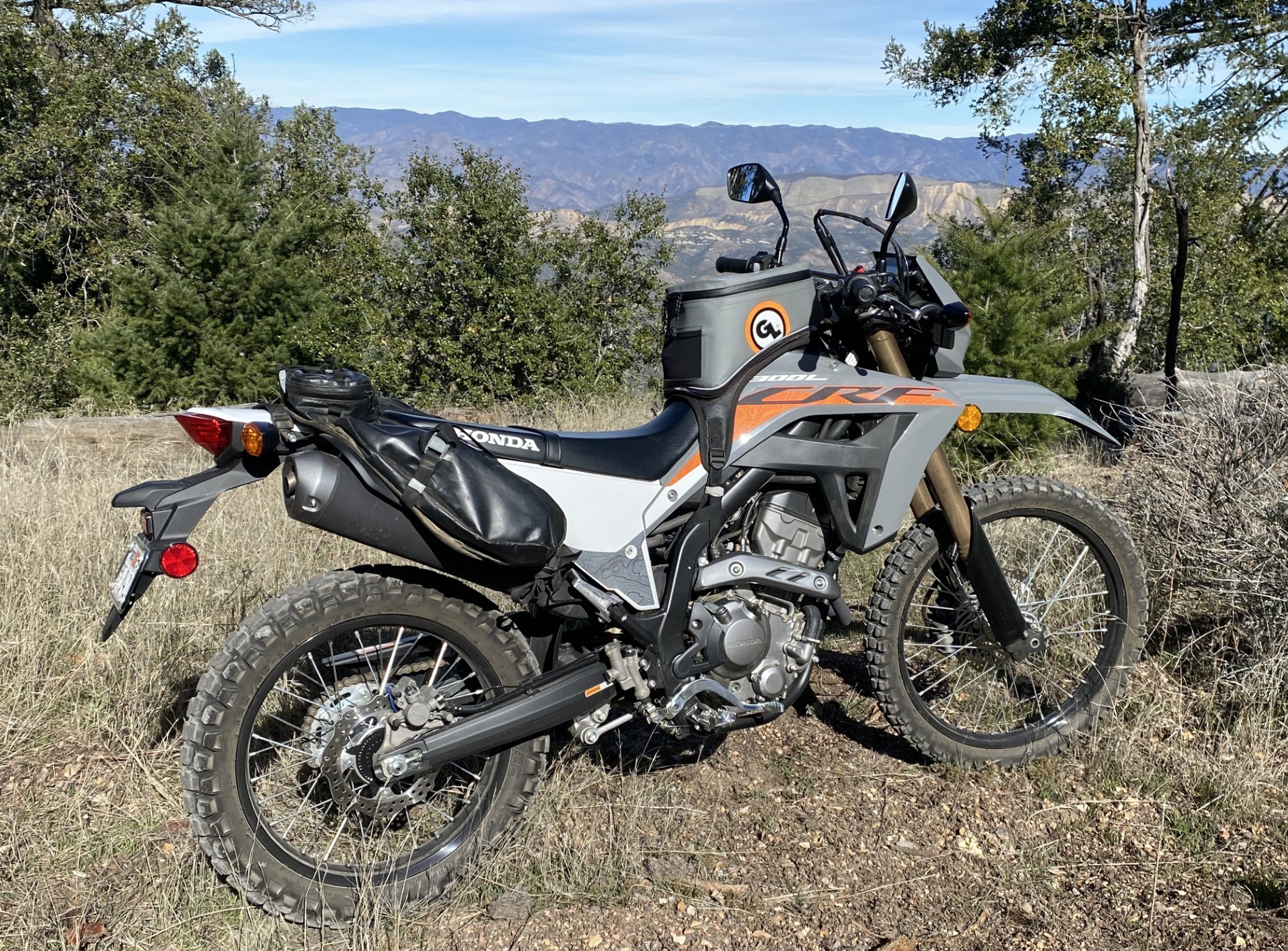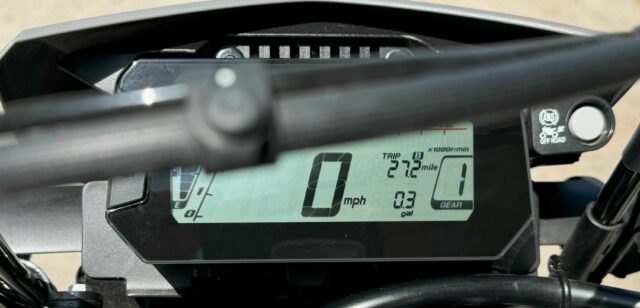The 2024 CRF300LS is Honda’s latest addition to their 300-class dual-sport line. A lowered version of the popular CRF300L, it’s another step in Honda’s initiative to make motorcycles accessible to more riders.
CRF300LS Genesis
I tested CRF300 L and Rally models at Honda’s 2021 press launch, finding them both capable and enjoyable. But they were also a stretch for my 31-inch inseam. Reading my mind (or more likely watching my feet dangle), Honda sliced 2 inches off the L’s 34.7-inch seat height to create the 2024 LS model.
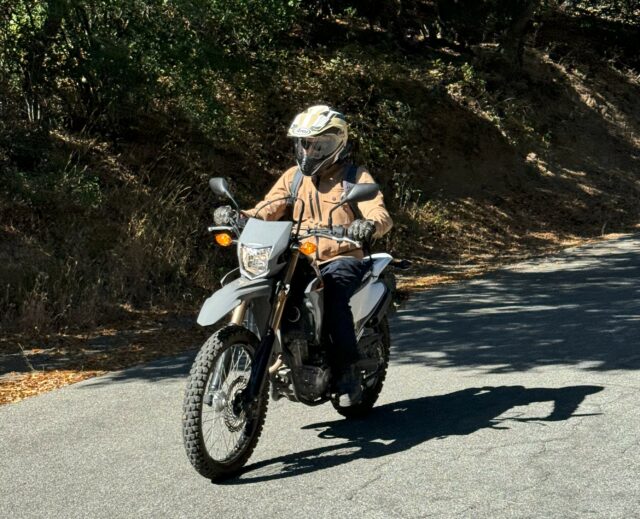
Aside from the lowering, the LS is the same motorcycle as the 300L. That means small gas tank (2.1 gallons), great mileage, 18- and 21-inch rims, and a peppy fuel-injected, 4-stroke single in the engine bay. And it comes stock with ABS, which is an add-on to the L.
Power Progression
The 300’s motor is a direct descendant of Honda’s long-lived CRF250L dual-sport mill, itself an upgrade from the CRF230L. An 8mm stroke increase gave the new single a 15 per cent displacement increase to 286cc. That, plus modified cam timing and lift produce noticeably more usable power than the 250. Honda claims it tops out at 26.7 horsepower. Redline is 10,500 rpm but revving that high isn’t productive. Dirt Rider’s dyno measured 22.7 ponies at 8,400 rpm and 16.7 pound-feet of torque at 6,400. My testing showed that was enough to cruise with fast traffic, strafe the twisties, and enjoy off-pavement hi-jinks.

Shifting Gears
The Honda’s six-speed tranny works flawlessly, requiring just the flick of a toe to shift up and a tap to gear down. A flat torque curve and five closely spaced cogs allow relaxed off-pavement riding for novices, while experienced riders can power-slide the corners with a twist of the wrist. Sixth is overdrive, great for keeping the revs and vibration down on the highway. The counter-balanced single still has a buzz, but it doesn’t intrude until the revs close in on 7,000 rpm, around 70 mph in sixth gear.

The CRF’s assist/slipper clutch reduces lever effort by nearly 20 per cent, a real plus for long technical rides and smaller riders. The slip function prevents rear-wheel hopping and sliding due to clumsy downshifting, and both features add a level of safety for new riders.
Climbing Aboard the CRF300LS
Honda took two approaches to lowering the bike’s seat height. First, by reducing the padding, leaving the perch firm but comfortable enough for all-day rides. Next, they decreased suspension travel from the L model’s 10.2 inches at both ends to 9.3 and 9.0 inches at the front and rear, respectively. As with the base machine, rear shock preload is the only suspension adjustment. The ride is soft without being spongy and works well no matter the road surface, though it does have its limits. With less ground clearance—9.6 inches vice 11.2 for the L model—bottoming is a consideration. A skid pan is the first accessory I’d buy for this motorcycle.
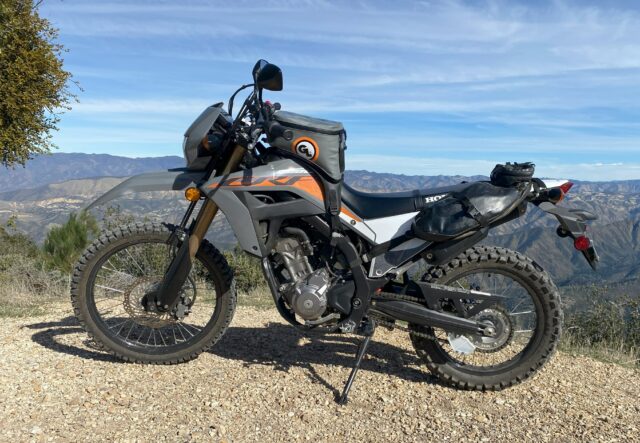
The CRF300LS rolls on spoked aluminum rims with 100/80-21 and 120/80-18 IRC Trails GP semi-knobbies. Though not premium rubber, they grip tight on pavement and will grab dirt well enough for kicking up some dust. The rear tire on our test machine was due for replacement at 2500 miles.
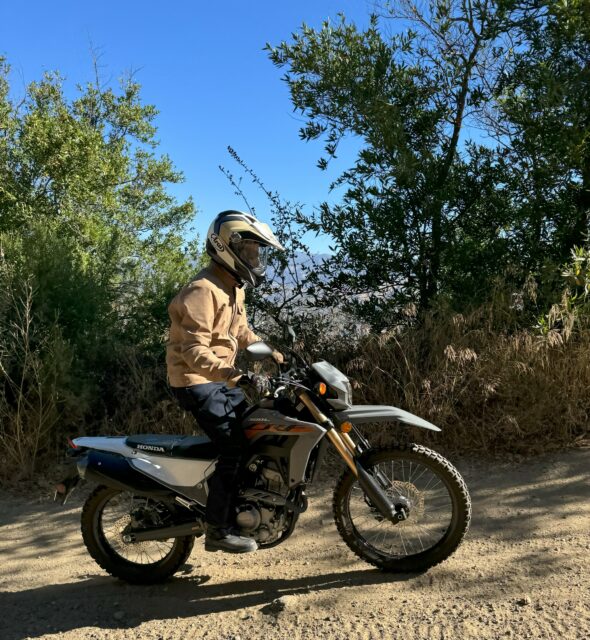
ABS Included
The 300’s easily modulated Nissin hydraulic disc brakes aren’t fancy but are up to the job of stopping in a hurry. The front brake uses a twin-piston caliper and 256mm disc, with a single-piston caliper clamping the 220mm rear disc. As noted, ABS is standard on this model, which makes it a good choice for first-timers. A button on the dash disengages the rear ABS for off-pavement riding—just stop, push, ride on. The one thing I don’t like is how the brake and ABS lines loop over the display and hide the left turn indicator. I’ve too often been “that guy” tooling down the road with his blinker on.
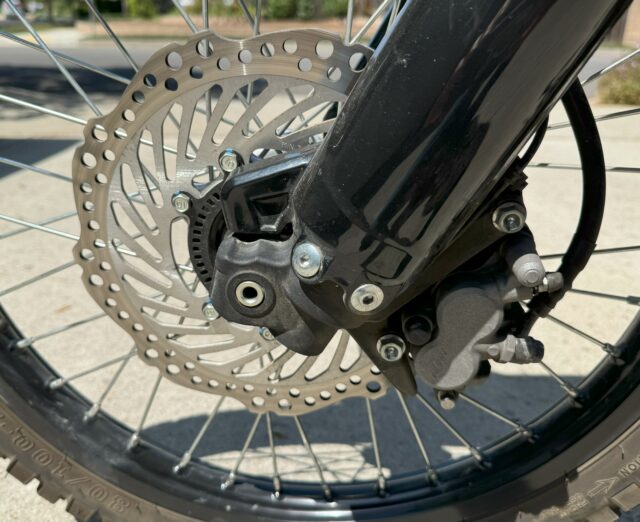
Electronics & Economy
The CRF300LS has a compact LCD instrument panel that presents almost everything I want in an easy-to-read format. Speed, odometer, trip meters, and current gear selected are digital, with bar graphs for fuel and rpm. Based on my experience with flaky gas gauges I was surprised to find that this one, plus the miles-per-gallon and gallons consumed displays, matched my gas log.
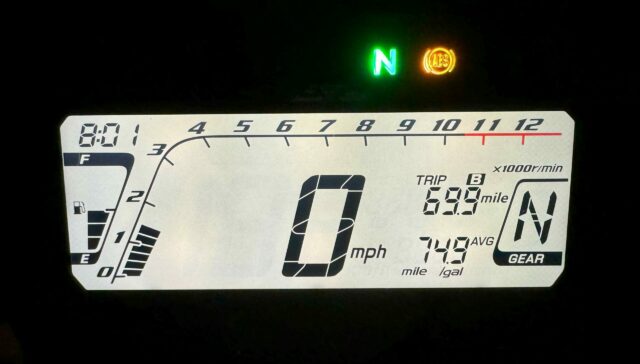 I frequently saw over 70 mpg from a tankful of regular grade fuel, of which there were many since range is less than 150 miles. My best run was 77.7 mpg on a brisk 50-mile ride from sea level to 4,200 feet and back, with miles of rolling ridge-top hills in between.
I frequently saw over 70 mpg from a tankful of regular grade fuel, of which there were many since range is less than 150 miles. My best run was 77.7 mpg on a brisk 50-mile ride from sea level to 4,200 feet and back, with miles of rolling ridge-top hills in between.
The weakest part of the Honda may be the headlight. It’s a standard 60/55-watt halogen bulb design that just doesn’t light up the night on low beam. I ride on high beam during the day and slow down considerably at night when I have to use low beam.
CRF300LS Comfort & Carry
Motorcycle comfort depends as much on the rider’s build as the motorcycle’s. For me, at 68-inches tall, the seat/handlebar/footpeg positions create a hospitable cockpit. Taller riders may prefer higher bars. A small windscreen and more seat padding would enhance longer excursions, but I’ve taken the LS on extended rides without complaint. The suspension soaks up everything from potholes in town to rocks and ruts in the boonies. I’ve ridden it for hours on everything from smooth freeway to crumbling asphalt to rocky dirt without complaint. It’s also right-sized for splitting lanes in California’s sluggish traffic.
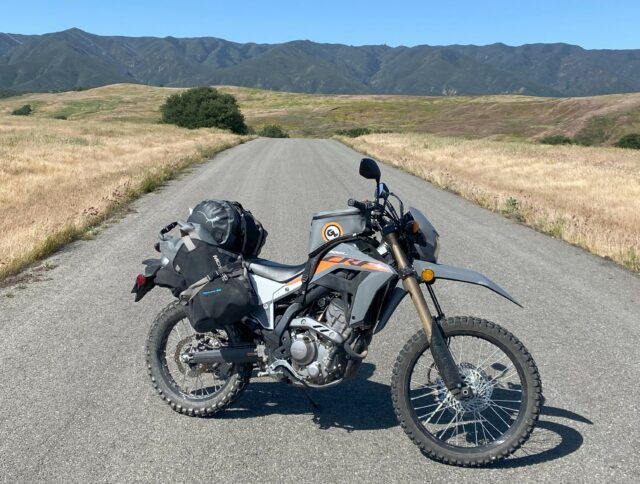
The CRF also travels well, though it needs a rear rack to simplify packing up. Still, I was able to securely attach my Mosko Moto Reckless 80L without too much trouble. And Giant Loop’s Fandango tank bag perches perfectly on the tank without affecting handling or vision. My aging set of their Mojavi saddlebags have found a new home on the 300, carrying tools, gas, and other gear on day rides.
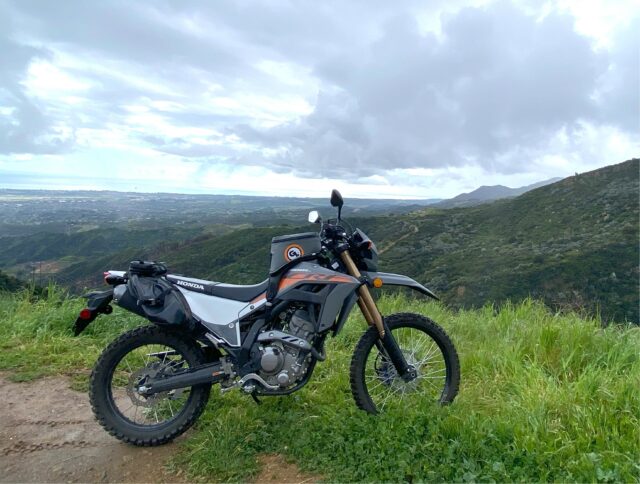
The Wrap-Up
My blanket statement for this machine is “what’s not to like?” It fills its role as an accessible dual-sport to a T. Decent power, good suspension, nimble handling, incredible fuel economy, and a low seat height make it fun for most anyone who enjoys two-wheeling. While not the best at anything, it’s good enough at everything to make it an excellent all-around motorcycle suitable for the city, highway, or backcountry. I’ve put over 2700 miles on our test bike and enjoyed every single one.
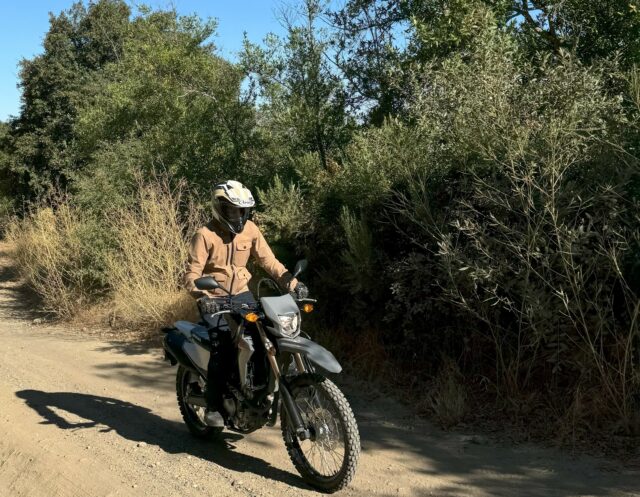
Specifications
Engine Type: 286cc liquid-cooled single-cylinder four-stroke
Bore And Stroke: 76mm x 63mm
Compression Ratio: 10.7:1
Valve Train: DOHC; four valves per cylinder
Induction: PGM-FI, 38mm throttle body
Power: 26.7 hp (claimed)
Transmission: Six-speed
Final Drive: #520 chain; 14T/40T
Front Suspension: 43mm inverted fork; 9.3-inch travel
Rear Suspension: Pro-Link ® single shock with adjustable spring preload; 9.0-inch travel
Front Brake: Single 256mm disc with twin-piston caliper
Rear Brake: Single 220mm disc
Front Tires: 80/100-21
Rear Tires: 120/80-18
Wheelbase: 56.7 inches 57.2 (0.5”)
Seat Height: 32.7 inches (34.7)
Ground Clearance: 9.6 inches (11.2) –find a comparison in other small bikes
Rake: 27.5°
Trail: 4.3 inches
Fuel Capacity: 2.1 gallons, including 0.5-gallon reserve
Curb Weight: 311 pounds (Includes all standard equipment, required fluids and full tank of fuel)
$5,749 | https://powersports.honda.com
Read more: Honda XR150L
Rider Clothing: Aether Mulholland Motorcycle Jacket; Rev’It Lombard 3 RF Motorcycle Jeans, Arai XD4 Helmet, Icon Gloves
Images: Honda, James Norris, Arden Kysely
Sources: Honda, Dirt Rider
Our No Compromise Clause: We do not accept advertorial content or allow advertising to influence our coverage, and our contributors are guaranteed editorial independence. Overland International may earn a small commission from affiliate links included in this article. We appreciate your support.


